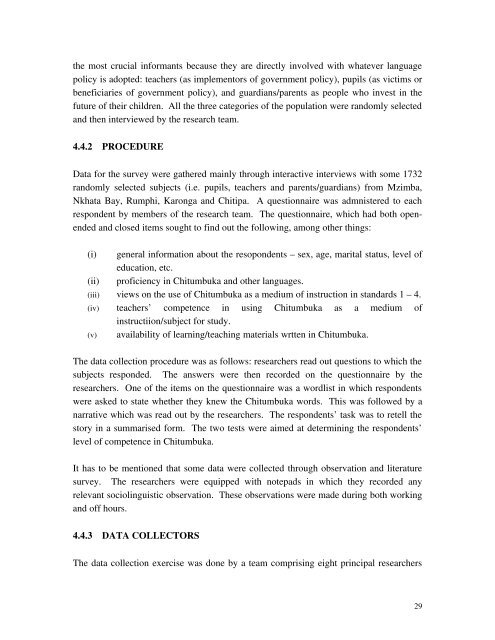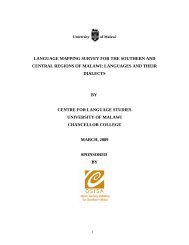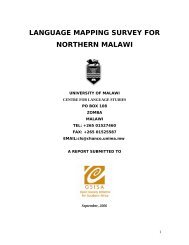SOCIOLOLINGUISTIC SURVEYS - Centre for Language Studies
SOCIOLOLINGUISTIC SURVEYS - Centre for Language Studies
SOCIOLOLINGUISTIC SURVEYS - Centre for Language Studies
You also want an ePaper? Increase the reach of your titles
YUMPU automatically turns print PDFs into web optimized ePapers that Google loves.
the most crucial in<strong>for</strong>mants because they are directly involved with whatever language<br />
policy is adopted: teachers (as implementors of government policy), pupils (as victims or<br />
beneficiaries of government policy), and guardians/parents as people who invest in the<br />
future of their children. All the three categories of the population were randomly selected<br />
and then interviewed by the research team.<br />
4.4.2 PROCEDURE<br />
Data <strong>for</strong> the survey were gathered mainly through interactive interviews with some 1732<br />
randomly selected subjects (i.e. pupils, teachers and parents/guardians) from Mzimba,<br />
Nkhata Bay, Rumphi, Karonga and Chitipa. A questionnaire was admnistered to each<br />
respondent by members of the research team. The questionnaire, which had both openended<br />
and closed items sought to find out the following, among other things:<br />
(i) general in<strong>for</strong>mation about the resopondents – sex, age, marital status, level of<br />
education, etc.<br />
(ii) proficiency in Chitumbuka and other languages.<br />
(iii) views on the use of Chitumbuka as a medium of instruction in standards 1 – 4.<br />
(iv) teachers’ competence in using Chitumbuka as a medium of<br />
instructiion/subject <strong>for</strong> study.<br />
(v) availability of learning/teaching materials wrtten in Chitumbuka.<br />
The data collection procedure was as follows: researchers read out questions to which the<br />
subjects responded. The answers were then recorded on the questionnaire by the<br />
researchers. One of the items on the questionnaire was a wordlist in which respondents<br />
were asked to state whether they knew the Chitumbuka words. This was followed by a<br />
narrative which was read out by the researchers. The respondents’ task was to retell the<br />
story in a summarised <strong>for</strong>m. The two tests were aimed at determining the respondents’<br />
level of competence in Chitumbuka.<br />
It has to be mentioned that some data were collected through observation and literature<br />
survey. The researchers were equipped with notepads in which they recorded any<br />
relevant sociolinguistic observation. These observations were made during both working<br />
and off hours.<br />
4.4.3 DATA COLLECTORS<br />
The data collection exercise was done by a team comprising eight principal researchers<br />
29





